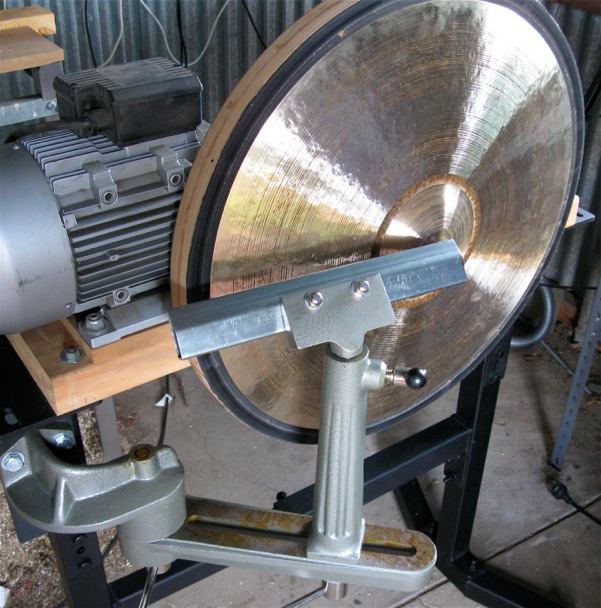Lathing

DISCLAIMER - ANYONE CHOOSING TO ENGAGE IN ANY CYMBALMAKING ACTIVITY DOES SO AT HIS/HER OWN RISK. CRAIG LAURITSEN AND/OR CYMBALUTOPIA ASSUMES NO LIABILITY FOR ANY PERSONAL AND/OR PROPERTY DAMAGE OR LOSS INCURRED BY ANYONE ATTEMPTING TO USE THIS INFORMATION.
A lathe is a potentially dangerous machine that must be treated with respect and all possible safety precautions taken when using it.
Pieces of sharp bronze can come hurtling at the user with great speed and force and so kill switches, gloves, eye protection, leather aprons etc are necessities.
The Basics-
- RPM - For B20, safety and cutting efficiency seems to work best in the 200 - 350 RPM range. This can be done with pulleys and belts or reduction gearboxes. B8 needs a lower speed; 180 RPM and below.
- Main Backing Plate - The lathe must have a backing plate which is sturdy and larger than the diameter of the cymbal.
- Profile Backing Plate - I have a number of different size and profile backing plates which fit onto the main backing plate to accommodate the profile of different cymbals.
- Tool Rest - The frame and tool rest assembly must be strong and sturdy. Mine is large gauge mild steel and cast steel.
- Kill Switch - You must have one for safety. Mine is foot operated.
- Motor - A strong electric motor (min 1 & 1/2 hp) which runs with appropriate rotational speed.
Lathe tools -
Tungsten Carbide lathe tools are needed to comfortably cut bronze. 3/8” to 1/2” are most functional. The faces can be sharpened and shaped with an appropriate bench grinder (min 1/2 hp) fitted with a silicon carbide wheel. These are placed into a lathe tool holder.

My Lathe -
The specs : 2hp motor, 2850 RPM, with a 24mm shaft - transferring power through the flexible coupling into the 19 mm input shaft of the 10 to 1 reduction gearbox which doubles as the headstock - reducing the center spindle speed to 285 RPM - the center spindle has a 210mm diameter cast iron balanced pulley attached to it, which is in turn attached to the backing plate - the motor and headstock are attached to a 45mm D x 180mm W x 750mm L piece of lumber, which is in turn attached to a heavy guage steel stand. The tool rest is heavy cast steel and has multiple adjustments for height, distance, angle etc. All the nuts are nylock. There's an emergency cut off switch which is foot operated.
I've done a lot of experiments with main component mounting and have ended up with some wooden parts as it seems to reduce vibration and subsequent lathe chatter. I also use rubber sheet on the front face of my backing plate.
Some Basic Tips -
Tools - The shape of the face of the tools you use, the material they’re made from (different grades of carbide, HSS etc.) and the end relief angle of the tool all have an impact on the final sonic outcome.
Machine - The speed of your machine affects the cutting efficiency and the amount of possible heat generation (another tool that can be used to influence sonic outcomes).
Speed and Feed - affect the cut and subsequent heat generation and are dependent in part on the machine and in greater part on the lathe operator’s technique.
As a basic rule, a smoother cymbal surface created using a larger, flatter faced tool, creates a smoother (less peaks and troughs and less overtones) sound and less volume.
Deeper and sharper grooves create more volume and more overtones ‘sticking out’.
The grooves can create more tension in a cymbal too, whereas a smooth surface when coupled with weight loss results in less overall tension.
A cymbal generally loses tension when lathed (the exact nature of this loss is dependent upon the lathing style) … more so when lathing from the bottom. A cymbal can also lose a little profile height if lathing away a lot of material or when installing a more extreme taper.
Heavier weight = higher tessitura, greater volume potential, slower response, longer sustain, fewer overtones, narrower frequency range, more stick definition (can be ‘pingy’ in heavier cymbals).
Less weight = lower pitch, less possible sustain.
Taper – greater taper (change of thickness from bell to edge) = lower tessitura, faster crash response, shorter decay.
Tension - the greater the overall tension in a cymbal, the faster the response, the greater the sustain and level of wash, greater prominence of higher frequencies.